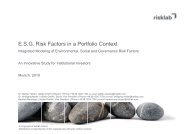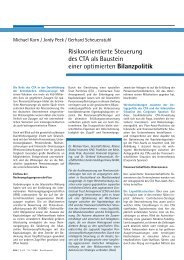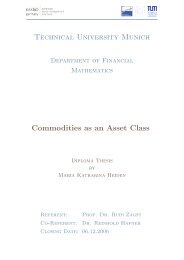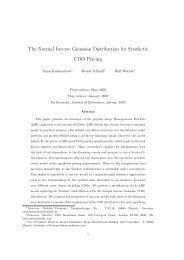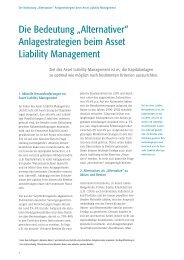Technische Universität München Credit as an Asset Class - risklab
Technische Universität München Credit as an Asset Class - risklab
Technische Universität München Credit as an Asset Class - risklab
You also want an ePaper? Increase the reach of your titles
YUMPU automatically turns print PDFs into web optimized ePapers that Google loves.
CHAPTER 2. CREDIT RISK TRANSFER<br />
Interest-rates c<strong>an</strong> be stipulated fixed or floating. In the c<strong>as</strong>e of floating interest-rates,<br />
there is usually a market interest-rate which is used <strong>as</strong> benchmark (for example LIBOR 5 ).<br />
The obligor h<strong>as</strong> to pay the benchmark rate plus a spread. Furthermore, lo<strong>an</strong>s c<strong>an</strong> be<br />
gr<strong>an</strong>ted unsecured or secured. Real estate or securities often serve <strong>as</strong> collateral.<br />
Apart from the presented specifications, there are much more variations in designing<br />
a lo<strong>an</strong> contract since it is a private agreement <strong>an</strong>d thus very flexible.<br />
Lo<strong>an</strong>s c<strong>an</strong> be cl<strong>as</strong>sified into defaultable or risky lo<strong>an</strong>s <strong>an</strong>d non-defaultable or (default)<br />
risk-free 6 lo<strong>an</strong>s, dependent on the obligor’s credit quality. ”Defaultable” is a term used<br />
for <strong>an</strong>y kind of lo<strong>an</strong> bearing credit risk, while a non-defaultable lo<strong>an</strong> h<strong>as</strong> no credit risk<br />
exposure, since the obligor h<strong>as</strong> the highest credit quality.<br />
Risks related to Lo<strong>an</strong>s<br />
Lenders <strong>an</strong>d obligors are exposed to several risks. Besides credit risk, which is discussed in<br />
Section 2.1.1, there are more risks inherent in lo<strong>an</strong>s. In the following, we give <strong>an</strong> overview<br />
on the most import<strong>an</strong>t ones.<br />
• Interest-rate risk– risk of a potential loss that could arise from a ch<strong>an</strong>ge of the market<br />
interest-rates.<br />
• Currency risk – risk of a potential loss that could arise from <strong>an</strong> adverse price ch<strong>an</strong>ge<br />
of foreign currency.<br />
• Inflation risk – risk of reduced real purch<strong>as</strong>ing power of future payments driven by<br />
inflation.<br />
A lo<strong>an</strong> is the oldest me<strong>an</strong>s of payment obligation <strong>an</strong>d it is still <strong>an</strong> import<strong>an</strong>t source<br />
of funding. Since lo<strong>an</strong> contracts are often non-st<strong>an</strong>dardised, it is difficult or impossible to<br />
trade single lo<strong>an</strong>s. In contr<strong>as</strong>t, bonds enable investors to trade debt. They are described<br />
in the following section.<br />
2.2.2 Bonds<br />
A bond is a securitised form of a lo<strong>an</strong>. At the issuing of a bond, the bond holder or lender<br />
buys the bond with a certain principal amount 7 from the issuer or borrower either at<br />
par, with <strong>an</strong> agio or a disagio. 8 By issuing bonds, the borrower commits itself to make<br />
stipulated payments comprising the repayment of the principal amount at maturity date<br />
<strong>an</strong>d interest or coupon payments at predefined coupon dates (for example <strong>an</strong>nually or<br />
semi-<strong>an</strong>nually) to the bond holder.<br />
Cl<strong>as</strong>sification of Bonds<br />
Analogous to lo<strong>an</strong>s, bonds c<strong>an</strong> be cl<strong>as</strong>sified into defaultable or risky bonds <strong>an</strong>d non-<br />
defaultable or (default) risk-free bonds. ”Defaultable bond” is a term for <strong>an</strong>y kind of<br />
5 LIBOR is the London InterB<strong>an</strong>k Offered Rate. It represents the interest-rate between b<strong>an</strong>ks.<br />
6 We use the term ”risk-free” if we consider a fin<strong>an</strong>cial instrument to be default risk-free.<br />
7 Analogue to lo<strong>an</strong>s, the principal amount is the amount which the issuer pays back at maturity <strong>an</strong>d<br />
it is the b<strong>as</strong>is for calculating the interest payments. We will also denote it by nominal amount, notional<br />
amount or simply notional.<br />
8 The me<strong>an</strong>ing of ”at par”, ”agio” <strong>an</strong>d ”disagio” is explained in Section 2.2.1.<br />
7



